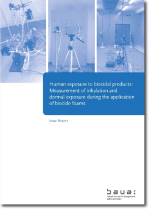- Project number: F 2366
- Institution: Federal Institute for Occupational Safety and Health (BAuA) / Fraunhofer-Gesellschaft zur Förderung der angewandten Forschung e.V. (FhG)
- Status: Completed Project
Description:
In commercial workplaces, biocidal products are applied using various methods, including foaming techniques. This project developed and assessed a practical procedure for the estimation of inhalation and dermal exposure to non-volatile biocidal substances when they are applied as foams.
In particular, the source strengths of the inhalable aerosols of active substances that are released and their deposition on surfaces were quantified for representative foaming and spraying processes, as well as a range of biocidal formulations. The investigations were carried out under controlled conditions in model rooms. Furthermore, the differences between foaming and spraying techniques for comparable processes were examined. The source strengths for the foaming processes were parameterised, related to available process parameters, and classified into three release categories on the basis of data about their utilisation in practice. This information concerning source strengths was used in a modified 2-box dispersion model, making it possible to predict levels of exposure in different situations. The quality of the results from the model rooms and the predictive modelling was evaluated by comparing them with measurements taken in real and simulated workplaces.
While inhalation exposure is lower when foaming processes are used than when biocidal products are sprayed, no relevant differences in dermal exposure are found between foaming and spraying. The reason for this is that dermal exposure is attributable above all to contacts when products are being handled and contamination caused by splashing, not the deposition of aerosols. In consequence, the dermal exposure data are highly consistent with the data from models currently used to assess spraying processes during authorisation procedures. These models are, however, insufficiently applicable to inhalation exposure where biocidal products are applied as foams. Here, according to the investigations, the modified 2-box model, predicated as it is on the classification of foaming processes into the release categories, allows conservative estimates of inhalation exposure to be made.
The theoretical and practical findings arrived at with regard to professional users’ inhalation and dermal exposure when applying biocidal foams are significant for the assessment of risks to human health in regulatory procedures. Furthermore, the development of appropriate models is to be part of the follow-up project being undertaken by the Federal Institute for Occupational Safety and Health (Bundesanstalt für Arbeitsschutz und Arbeitsmedizin, BAuA), “Modular model approaches for exposure assessment for risk assessment at the workplace in the context of chemical safety”.
